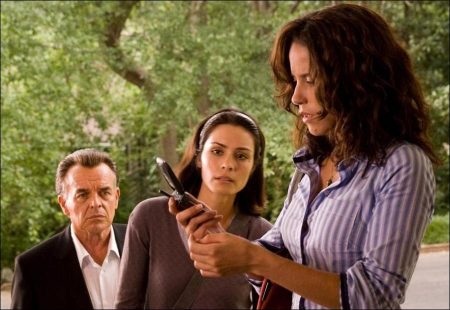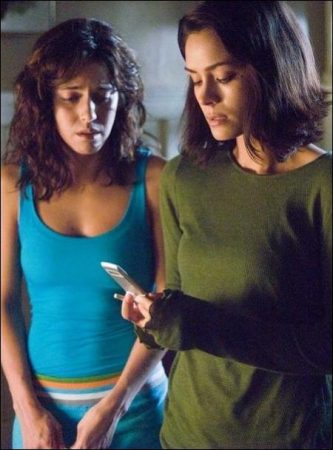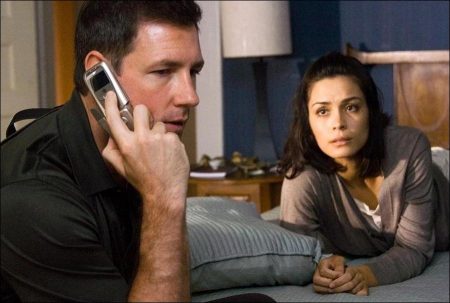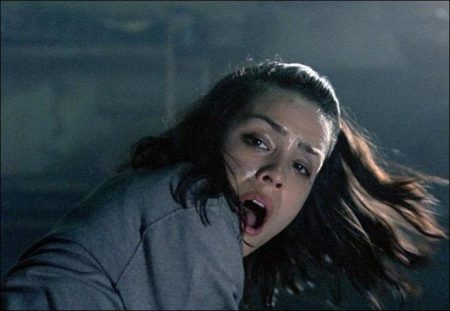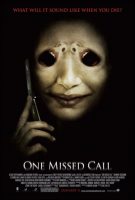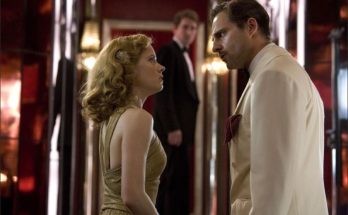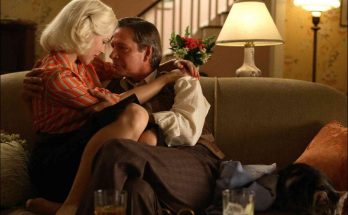Tagline: What will it sound like when you die?
A chain of people receive terrifying cell phone messages of their own final fatal moments. Though the messages can be deleted, their number is up. Beth Raymond (Shannyn Sossamon) is traumatized when she witnesses the gruesome deaths of two friends just days apart. Even more disturbing, she knows that both of them had received chilling cell phone messages—actual recordings of their own horrifying last moments. Impossibly, the calls were received days before they died, but each death occurred precisely when and how the messages foretold.
The police think Beth is delusional—except for Detective Jack Andrews (Edward Burns) whose own sister was killed in a freak accident that bears a strange similarity to the deaths of Beth’s friends. Together, Jack and Beth work feverishly to unravel the mystery behind the ominous calls. But even as they get closer to the truth, Beth’s cell phone begins to ring with an eerie tune, and the readout says One Missed Call.
One Missed Call is a 2008 supernatural horror film directed by Eric Valette and written by Andrew Klavan. An international co-production between the United States, the United Kingdom, Japan, and Germany, it is a remake of the 2003 Japanese film of the same name directed by Takashi Miike, which itself was based on the Yasushi Akimoto novel Chakushin Ari. The film stars Shannyn Sossamon, Edward Burns, Ana Claudia Talancón, Ray Wise and Azura Skye.
One Missed Call opened in 2,240 theaters on January 4, 2008. The film earned US$5.2 million on its opening day and $12,511,473 on its first weekend, ranking #5 at the North American box office. The film grossed $26,890,041 in the United States and $18,957,710 overseas for a worldwide total of $45,847,751.
About the Production
The innocuous phrase “One Missed Call” has become part of the cultural lexicon since cell phones have become an essential part of everyday life. Seeing these three simple words appear on a cell phone typically evokes feelings of curiosity or frustration, but, for Beth Raymond and her friends, these words create nothing but bone-chilling fear. “What kind of terror could an evil spirit unleash if it traveled through cellular waves?” asks director Eric Valette. “It’s a simple concept, but what really attracted me to this project was the depth of the story and its universal themes.”
The origins of “One Missed Call” stem from the novel “Chakushin Ari” by acclaimed Japanese author Yasushi Akimoto. The novel was first adapted as a feature film by noted Japanese director Takashi Miike in 2003. In remaking the Japanese hit thriller for U.S. audiences, producer Jennie Lew Tugend notes, “I think ghost stories are pretty universal. The idea of someone dying unjustly and leaving behind unfinished business transcends culture, and the idea that the spirit of this person is trying to frighten you or do away with you is truly unsettling.” “This is not a violent movie, but it is a scary one,” says producer Andrew A. Kosove. “The scares come from unexpected events that are shocking to the psyche.”
“By combining a disquieted spirit with cell phone technology, we’re giving the classic ghost story a modern twist,” offers producer Lauren C. Weissman. “The concept of receiving a ‘death call,’ a voice message that forecasts your death three days in the future, seemed frightening and fun.”
To pen the American adaptation of the screenplay for “One Missed Call,” the filmmakers tapped the talents of novelist and screenwriter Andrew Klavan. A fan of the Japanese horror or “J-horror” genre, Klavan recalls, “Producer Scott Kroopf sent me a DVD of the original version. I was traveling at the time, so I watched the DVD on my laptop in my hotel room. By the end of it, I was so scared I had my hands over my eyes and was watching through my fingers. I wanted to fast-forward but I couldn’t; I was riveted.”
One of the challenges Klavan faced in adapting the screenplay was modifying structural elements of the story to appeal to Western sensibilities while staying true to the original. He says, “While the concept of ‘One Missed Call’ extends beyond language and cultural barriers, the original film assumes that its audience is aware of Japanese urban legends and other culturally specific supernatural traditions, which few Americans are familiar with. This prompted me to adapt some of these elements into images and ideas that would be more meaningful and frightening to U.S. audiences.”
Kroopf adds, “We stayed true to the original concept, but in reworking the story, we realized what might be scary to an audience in Japan may not have the same effect on a Western audience. Pacing also tends to vary between U.S. and Japanese films, so it was important for us to find a director who could appreciate both.”
Tugend offers, “In our search for directors, we came across Eric Valette’s French thriller, ‘Maléfique.’ The film is set in a prison with a group of inmates who share a cell. They find a book of spells and try to use it for escape, but things do not go as planned. We were amazed at the way Eric was able to tell the story in such a small space, and how much we were on the edge of our seats throughout the film.”
Kosove notes, “In that film, Eric was able to create such a sense of tension and mystery with a minimal amount of resources. His directing style has a uniquely handcrafted quality that is matched with grounded and compelling performances. From all of this, we were very confident that Eric could really bring something special and unique to the material.”
“Even in our preliminary meetings with Eric,” recounts Johnson, “he took major steps to help us formulate the direction of the movie. He wrote extensive notes, which he sent to all of us. He also created storyboards and compiled reference art to present his vision of the film.”
Kroopf adds, “Eric understood exactly what to do with the characters and their relationships in order to escalate the sense of dread and terror that the story required. He was very decisive and knew what he wanted.”
“The audience for this kind of film expects certain things,” reflects Weissman. “They love horror films but, at the end of the day, this is also a ghost story. Eric understood this and knew how to create an experience that builds on the suspense as the story goes on.”
Making his American feature directing debut, the French director offers, “For me, ‘One Missed Call’ has the feel of 1970s horror movies that I really love watching. It’s character-driven and unpredictable. At same time, the story is contemporary because it is set in a world where virtually everyone has a cell phone. And, in this world, we’re apparently not the only ones who’ve learned how to use this technology.”
Caller ID
One Missed Call” takes place over several terrifying days in the life of Beth Raymond, a psychology student whose friends fall victim to the frightening death calls. Detective Jack Andrews, who lost his sister in a mysterious hospital fire, finds a bizarre link between the death of his sister and the deaths of Beth’s friends. When Beth finally gets her call, she and Jack race against the clock to break the chain of terror and confront the evil.
Shannyn Sossamon was cast in the role of Beth Raymond. The actress notes, “On the surface, Beth is very much in control. She’s a good student and a very good friend; she’s always there for the people she cares about. However, she’s hiding a major bag of pain, which unfolds as the evil spirit at the center of the story forces her to face her inner demons.”
“Shannyn was on the top of my list for the role of Beth,” Valette states. “I saw her in `Rules of Attraction’ and I thought she was perfect for the part. She is a great actress and understands the subtlety that I felt was essential for the character.”
Kroopf adds, “Shannyn is an incredibly talented actress. She also has a very down-to-earth quality, which fit the character well. Beth is a caring individual who is like a big sister to all of her friends. As the story progresses, we find out that her selflessness is a byproduct of repressed childhood memories. We felt strongly that Shannyn could pull off this multi-layered personality on screen.”
A number of factors attracted Sossamon to the project. “I thought the script was really well-developed. I liked the theme of disconnection, which is ironic because we’re all connected via our cell phone directories in this day and age,” says the actress. “Also, Eric’s enthusiasm is very contagious. I could tell from the first time we met that I would feel very comfortable with him. He is so real and so creative that you can’t help but be excited as well. And, he was very adamant about keeping situations in the film grounded and rooted in reality.”
At the beginning of the film, Beth lives in the idyllic setting of an American university as a graduate student. Constantly surrounded by friends and classmates, she is well-insulated from the outside world and from her dark past. “Everything’s fine in Beth’s life until her friends start receiving mysterious phone calls. When they check their voicemail, they hear a horrifying recording of themselves dying,” explains Sossamon. “Then, exactly three days from the original call, fate catches up with them and they die verbatim to their voicemail.”
In the days following each call, the victims experience disturbing hallucinations, and at the time of each death, a piece of red hard candy falls out of the mouths of each victim, suggesting that something otherworldly could be at play. “Try explaining a supernatural phenomenon to the local police, and they’ll have you committed,” laughs Sossamon.
If it weren’t for detective Jack Andrews, Beth very well may have been. Jack Andrews is played by Ed Burns, who in fact comes from a family of NYPD officers. “My dad, my uncle, five of my cousins and three of my best friends from childhood are cops. It’s a very familiar world to me,” says Burns.
Upon hearing the terrible news about his sister, Jean, Jack rushes to the morgue to identify her body and collect her belongings, and in doing so, finds a red hard candy inside the mouth of his sister’s corpse. None of it makes much sense until he overhears Beth describing her experience to a skeptical police officer in the precinct. “Jack is the only guy at the station who will listen to Beth’s stories since her friends all died with a piece of red hard candy in their mouths,” states Burns.
“Jack and Beth are the only ones who see a connection between the deaths,” says Andrew Kosove. “As they start to connect the pieces, they’re drawn by their common desire to figure out what’s going on.”
One of the things Burns says he responded to most in the screenplay was the connection between Beth and Jack, a complicated relationship that evolves throughout the course of the film. “The relationship that develops between Beth and Jack in the film is a classic, old-school Hollywood movie relationship.”
“It’s a special part of the film,” offers Sossamon. “To Beth, Jack is handsome and very much a gentleman. When they first meet, he genuinely tries to help her figure out why her friends are dying, with no ulterior motives. There is an attraction, but they’re guarded with each other because they’ve witnessed so much horror. The dynamic between them is very intense.”
A filmmaker himself, Burns was excited to work with Valette after he saw “Maléfique.” He notes, “Having never done a horror film before as either an actor or director, I kept a close eye on the amount of coverage and the type of coverage Eric got to learn more about directing this type of movie. There’s an elegance and method to how he builds tension and suspense.”
Valette, who had equal praise, notes, “Ed is very cool and laid-back, and very sharp. He is a great actor, and since he is also a director, he understands all of the directing shorthand and can appreciate the challenges a director faces on set. He is perfect for the role of Jack because he is very authentic and brings a lot of stability to the role with a hint of vulnerability.”
Working with Burns for the first time, Sossamon remarks, “Ed and I got along really well and we were always on the same page. He is very good at what he does, and always made me laugh.”
“Shannyn was terrific,” comments Burns. “She is very dedicated and focused, and fun to work with. She has a great sense of humor, and could always put up with my shenanigans. And we felt the same way about working with Eric. We knew we were in good hands on set.”
Up-and-coming actress Ana Claudia Talancon stars as Beth’s best friend Taylor Anthony. When Taylor receives her death call, she tries desperately to escape the inescapable. “Taylor is especially forlorn when she receives a call because she has seen what happened to her friends,” says Broderick Johnson. “She knows that the clock is ticking.” In her desperation, Taylor finds hope—albeit false hope—in the ruthless reality television producer Ted Summers, played by Ray Wise. Wise’s character offers Taylor a chance at salvation from imminent doom by offering her a televised exorcism on his reality show, “American Miracles.”
Wise notes, “As soon as my character hears that something supernatural has occurred, he is ready to jump on it, believing that it could provide great material for his show. He aggressively seeks out Taylor and sells her on the idea, convincing her that the show will save her.”
Talancon welcomed the challenge of filming the exorcism scene, an intense sequence that took one week to shoot. “It was an emotional rollercoaster, going back and forth and in and out of the scene between takes and lighting setups. I was exhausted by the end of each day,” she recalls.
Completing Beth’s circle of doomed friends are Leann Cole, played by Azura Skye; Brian Sousa, played by Johnny Lewis; and Shelley Baum, played by Meagan Good. Actress-comedienne Margaret Cho plays skeptical police officer Mickey Lee, who underestimates the gravity of Beth’s paranormal accounts, and Jason Beghe plays the “American Miracles” on-air exorcist, Ray Purvis.
Dialing In On Darkness
In crafting the look and feel of “One Missed Call,” Valette describes his visual approach as “gritty and realistic; dark and grounded. I went for a subdued sense of creepiness that comes from subtle sound effects and light changes. I wanted to create a truly visceral experience.”
Valette focused a lot of attention on designing the elements for the ghostly hallucinations as seen by death call victims. “Credit goes to Eric for coming up with some brilliant ideas on envisioning the ghosts,” says Lauren C. Weissman. “He spent months working with our designers to come up with some of the most frightening images in the film. We updated the looks considerably and I think the result is unique and decidedly scary.”
Special effects makeup production supervisor Brian Walsh states, “The makeup effects in this movie are key because most of the characters we created are not outright grotesque; instead they are more shocking and deranged looking than anything else.” Jennie Lew Tugend adds, “Eric didn’t want the apparitions to look like zombies and ghouls. He always emphasized ‘different,’ ‘disturbing’ and ‘off-putting.’”
Valette achieved this by giving supernatural manifestations in the film the look of antique porcelain dolls, which, according to Walsh, “have an inherent creepiness about them. Most porcelain dolls are eerily smooth and pale, and we made them even more frightening by texturing their faces with movement underneath the surface of the skin and added cracks on the surface that spread open.”
While the filmmakers endeavored to limit the use of digital visual effects, CGI gave Valette more control over animating hallucination scenes, and allowed him to stay true to his original storyboards. A visual effects team from Zoic Studios was tapped to combine practical elements and CGI for seamless digital compositing of the scenes. Principal photography began in late July 2006 in various parts of Atlanta, using existing locations, including the campus of Georgia Tech. “We made the most out of Atlanta. It’s a beautiful city,” says Valette, who is a native of Paris.
“I’m very glad I had the chance to contribute my vision to this chilling ghost story, and the cast and crew really came through,” Valette concludes. “Now I just hope this film scares the hell out of audiences, and that every time you miss a call, you will think of this movie.”
One Missed Call (2008)
Directed by: Eric Valette
Starring: Ed Burns, Shannyn Sossamon, Ana Claudia Talancon, Ray Wise, Azura Skye, Johnny Lewis, Margaret Cho, Meagan Good, Rhoda Griffis, Ariel Winter, Raegan Lamb, Karen Beyer
Screenplay by: Andrew Klavan
Production Design by: Laurence Bennett
Cinematography by: Glen MacPherson
Film Editing by: Steve Mirkovich
Costume Design by: Sandra Hernandez
Set Decoration by: Frank Galline
Art Direction by: Christina Ann Wilson
Music by: Reinhold Heil, Johnny Klimek
MPAA Rating: PG-13 for sequences of violence and terror, frightening images, sexual material, thematic elements.
Distributed by: Warner Bros. Pictures
Release Date: January 4, 2008
Visits: 55
